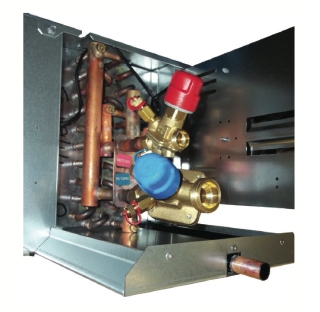There’s no stopping fan-coil units

The popularity of fan-coil units in air-conditioning systems has gone up and down over the years, but John Lightfoot argues that evolving technology makes them as valid an approach today as they have been in the past.
Chilled-water fan-coil technology has been an integral part of the UK and mainland Europe’s building-services market for more than 50 years. The technology’s popularity would not have lasted this long had it not served the market place well.
Other technologies that were considered technically superior by some have, in the last 50 years, come and gone, as fan coils continued their prominent position in the market place due to their unique combination of being one of the most flexible and cost-effective air-conditioning systems available in the building-services design engineer’s tool box.
The technology of chilled-water fan coils is evolving at its fastest rate since its introduction into the market place. The demand for cost-effective air-conditioning systems that can meet increasingly stringent Building Regulations whilst still providing the flexibility most clients demand in today’s fast-changing environment is pushing all manufacturers to adapt and improve their product offering at an ever-increasing pace.
The EU’s revised F-Gas Regulation Briefing Note, published back in December 2013, is suggesting a phase-down mechanism involving a gradually declining cap on the total placement of bulk HFCs (in tonnes of CO2 equivalent) by as much as 55% by 2021 (based on the average placed on the EU market between 2009 to 2012). This is, quite rightly, affecting the design engineer’s decision process as to what system will best meet his client’s needs now and into the future.
 |
| Fan coil units continue their prominent position in the market place. |
This reduction of 55% will, however, effectively be even further increased beyond this headline figure given that from 1st January 2017 any imported refrigeration, air-conditioning or heat-pump equipment charged with HFCs cannot be placed on the market unless their charge is accounted for within the HFC quota system. The laws of supply and demand will undoubtedly kick in — raising the potential for HFC refrigerants becoming a very expensive commodity. This prospect will obviously influence building-services design engineers to reconsider the viability of any air-conditioning system or technology that requires significant volumes of HFC refrigerant.
In conjunction with the great strides that have been, and are being made, to improve the seasonal efficiencies of chillers, fan-coil technology is also on the same trajectory. One of the great improvements made to fan-coil units over the last few years has been the introduction of EC/DC fan motors, which have not only slashed the energy consumption of fan coils, but also dramatically increased the number of control options available, which, in turn, has helped to further reduce the overall energy consumption and, therefore, running cost of systems.
The advent of the use of EC/DC fan motors into fan coils has also introduced the opportunity to significantly reduce energy consumption and running costs by simply designing the fan coil to work against a 20 Pa resistance rather than the traditional 30 Pa resistance everybody has used in the past as their standard. Designing around 20 Pa rather than 30 Pa with AC fan motors had little effect, if any, in reality, but with EC/DC fans their specific fan power can be significantly enhanced, thus helping to meet those all important Part L requirements as well as reducing the carbon footprint of a client’s building.
Where energy or carbon savings are paramount, chilled-water fan-coil systems can now be designed utilising higher water flow temperatures, similar to those used with chilled beams, which obviously dramatically improves the energy efficiency ratio (EER) and seasonal energy efficiency ratio (SEER) of the chiller. In addition to these savings, higher water flow temperatures also allow energy and running costs to be dramatically driven down by utilising ‘free cooling’ available during the cooler parts of the year.
 |
To make the industry more aware of the sort of savings that can be made by utilising higher water temperatures and free cooling, HEVAC’s Fan Coil Unit Group has commissioned Environmental Design Solutions Ltd (EDSL), which developed the thermal analysis software (Tas) used by the DCLG for Part L of the Building Regulations and EPC calculations, to carry out an energy study on a typical building situated in London. Once available it is the intention of the Fan Coil Unit Group to make this study fully available on FETA’s web site.
These innovations in fan-coil technology are not the last to be seen. As just one example, manufacturers are now working on innovations that will negate the use of air filters in fan coils — reducing both the consumption of fan motors even further, whilst also reducing maintenance costs. Fan-coil technology may have been around for a while, but the continuing developments by fan-coil manufacturers is ensuring the technology will be around for a good while longer!
John Lightfoot is Chairman of the HEVAC Fan Coil Unit Group and Director of TEV Ltd. HEVAC is the Heating, Ventilating & Air Conditioning Manufacturers’ Association and is part of the Federation of Environmental Trade Associations (FETA).







